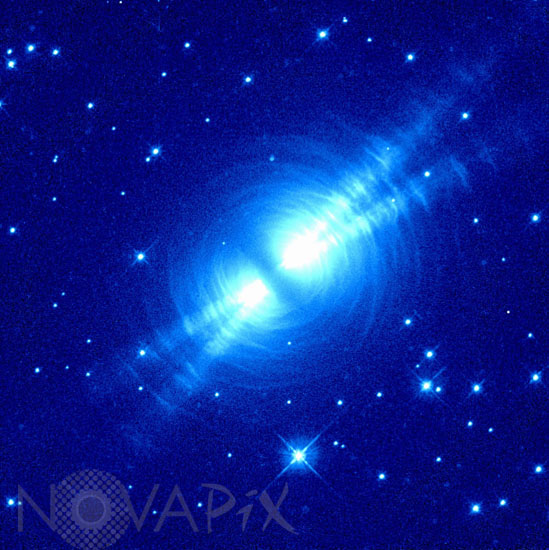Photo Agency - Astronomy - Space - Nature

Protoplanetary nebula CRL 2688 in Cygnus
author: Nasa/Novapix
reference: a-nep98-00100
Image Size 300 DPI: 17 * 17 cm
This image of the Egg Nebula, also known as CRL2688 and located roughly 3,000 light-years from us, was taken in red light with the Wide Field and Planetary Camera 2 (WFPC2) aboard NASA's Hubble Space Telescope.The image shows a pair of mysterious "searchlight" beams emerging from a hidden star, criss-crossed by numerous bright arcs. This image sheds new light on the poorly understood ejection of stellar matter which accompanies the slow death of Sun-like stars. The image is shown in false color. The central star in CRL2688 was a red giant a few hundred years ago. The nebula is really a large cloud of dust and gas ejected by the star, expanding at a speed of 20 km/s (115,000 mph). A dense cocoon of dust (the dark band in the image center) enshrouds the star and hides it from our view. Starlight escapes more easily in directions where the cocoon is thinner, and is reflected towards us by dust particles in the cloud, giving it its overall appearance. Objects like CRL2688 are rare because they are in an evolutionary phase which lasts for a very short time (~1,000 to 2,000 years). However, they may hold the key to our understanding of how red giant stars transform themselves into planetary nebulae. For the first time, we can see a 10,000 year-old history of mass-ejection in a red giant star in such exquisite detail. The arcs in CRL2688 represent dense shells of matter within a smooth cloud, and show that the rate of mass ejection from the central star has varied on time scales of ~100 to 500 years throughout its mass-loss history. With Hubble we have detected matter in this nebula to a radius of 0.6 light-years -- much further out than has been possible before, giving a better estimate of the amount of matter in the nebula. Other unexpected results seen in this image are the very sharply defined edges of the beams and fine spoke-like features which suggest that, contrary to previous models, the searchlight beams are formed as a result of starlight escaping from ring-shaped holes in the cocoon surrounding the star. The spoke- like features result from shadows cast by blobs of material distributed within the region of the ring-like holes. Such holes may be carved out by a wobbling,high-speed stream of matter -- they will play a crucial role in the shaping of the planetary nebula which will result from CRL2688.Alternatively, the searchlight beams may result from starlight reflected off fine jet-like streams of matter being ejected from the center, and confined to the walls of a conical region around the symmetry axis. Such fine jets are not unprecedented: they have recently been observed in Hubble images of a planetary nebula (the Cat's Eye Nebula). Both the above scenarios require the ejection of high-speed material in a narrow beam. The presence of such material in CRL2688 has been inferred from other observations. However, the mechanism for ejecting high-speed jets or for producing the cocoon are not understood. But it seems likely that if the central star in such objects has a faint companion star, the gravitational interaction between the two stars and/or the outflowing matter from the red giant star may play an important role in the production of the cocoon and the jets. When Sun-like stars get old, they become cooler and redder, increasing their sizes and energy output tremendously: they are called red giants.Most of the carbon (the basis of life) and particulate matter (crucial building blocks of solar systems like ours) in the universe is manufactured and dispersed by red giant stars. When the red giant star has ejected all of its outer layers, the ultraviolet radiation from the exposed hot stellar core makes the surrounding cloud of matter created during the red giant phase glow: the object becomes a planetary nebula. A long-standing puzzle is how planetary nebulae acquire their complex shapes and symmetries, since red giants and the gas/dust clouds surrounding them are mostly round. Hubble's ability to see very fine structural details (usually blurred beyond recognition in ground-based images) enables us to look for clues to this puzzle.
Contact : Stéphane Aubin +33-(0)9-51-26-53-76
© Novapix - All rights reserved


